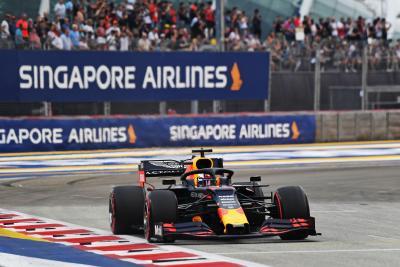
FIA Declares Singapore Grand Prix A 'Heat Hazard' Race Under New Rule
The ruling, announced by the FIA, was triggered by forecasts predicting temperatures above 31°C in Singapore's humid tropical climate. The decision means all teams must install cooling-vest systems in their cars, although use by drivers will not be mandatory. The measure is designed to prevent any competitive advantage if some drivers choose to race without the additional weight of the system.
Singapore has long been considered one of the toughest venues on the F1 calendar due to its relentless heat, high humidity, the bumpy Marina Bay street circuit, and the length of the race, which typically runs close to the two-hour maximum.
The idea of a driver-cooling system gained traction after the 2023 Qatar Grand Prix, when extreme conditions left several drivers on the brink of collapse. Frenchman Esteban Ocon vomited in his helmet mid-race, Williams' Logan Sargeant retired due to exhaustion, and others required medical attention afterwards.
Williams driver and Grand Prix Drivers' Association director Carlos Sainz called the FIA's move“fair.”
“Only hot is not too bad for us. We have that, for example, in Hungary, where it gets really hot but it's not humid. Humidity on its own is not too bad at all if it's not too hot. But when it's 28C, 30C degrees plus humid, that's when it gets to Singapore levels and it's tough,” Sainz was quoted by BBC Sport as saying.
Sainz, who has raced 10 times at Marina Bay, added that while the cooling vests are still evolving, they are improving:“Teams are managing to make it work better and better every time we run it. At the beginning, we had to work more or less for half an hour or so. Hopefully, now the whole system can work at least for an hour. It's a two-hour race. If it breaks or it doesn't work, I'm not worried. I'll do the race and jump out fresh like I always do. But if it works, it's better, because then you suffer a bit less.”
The Spaniard confirmed he had tried the vest during the Saudi Arabian Grand Prix earlier this year, where it lasted about 15-20 minutes. Mercedes driver George Russell also tested the technology in Bahrain, and told BBC Sport that it was“definitely very noticeable.”
“At the start of the race, it was about 16°C pumping around my body, which feels quite nice when you're in a cockpit that's 50°C-plus,” Russell said.

Legal Disclaimer:
MENAFN provides the
information “as is” without warranty of any kind. We do not accept
any responsibility or liability for the accuracy, content, images,
videos, licenses, completeness, legality, or reliability of the information
contained in this article. If you have any complaints or copyright
issues related to this article, kindly contact the provider above.
Most popular stories
Market Research

- Ethereum-Based Defi Crypto Mutuum Finance (MUTM) Reaches 50% Completion In Phase 6
- Casper (CSPR) Is Listed On Gate As Part Of Continued U.S. Market Expansion
- Ethereum-Based Defi Crypto Mutuum Finance (MUTM) Raises Over $16 Million With More Than 720M Tokens Sold
- Tokenfi And New To The Street Announce National Media Partnership To Reach 219M+ Households
- Flexm Recognized As“Highly Commended” In The Regtech Category At The Asia Fintech Awards Singapore 2025
- Forex Expo Dubai 2025 Conference To Feature 150+ Global FX And Fintech Leaders




















Comments
No comment